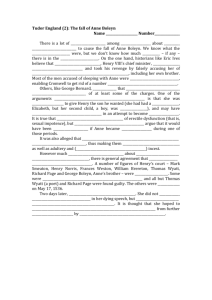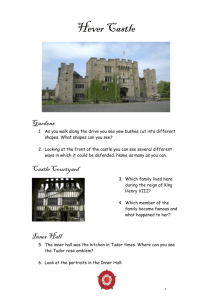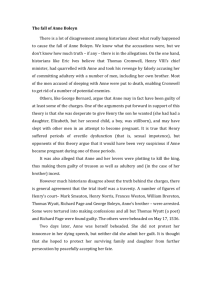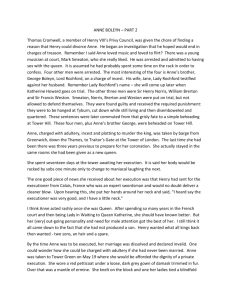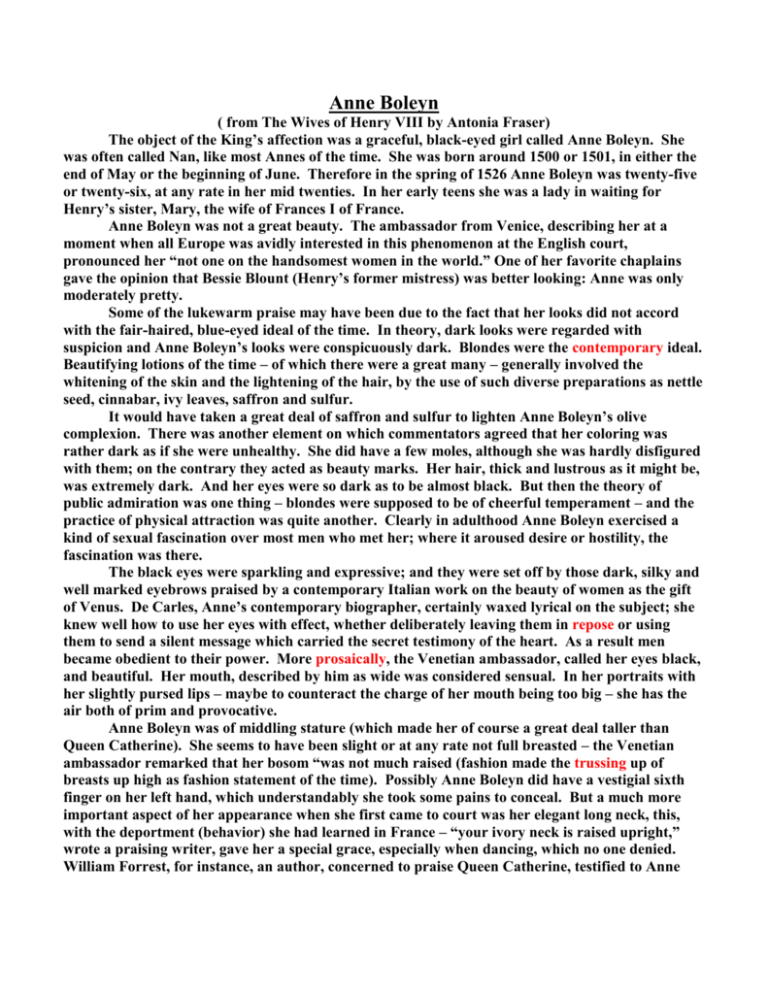
Anne Boleyn
( from The Wives of Henry VIII by Antonia Fraser)
The object of the King’s affection was a graceful, black-eyed girl called Anne Boleyn. She
was often called Nan, like most Annes of the time. She was born around 1500 or 1501, in either the
end of May or the beginning of June. Therefore in the spring of 1526 Anne Boleyn was twenty-five
or twenty-six, at any rate in her mid twenties. In her early teens she was a lady in waiting for
Henry’s sister, Mary, the wife of Frances I of France.
Anne Boleyn was not a great beauty. The ambassador from Venice, describing her at a
moment when all Europe was avidly interested in this phenomenon at the English court,
pronounced her “not one on the handsomest women in the world.” One of her favorite chaplains
gave the opinion that Bessie Blount (Henry’s former mistress) was better looking: Anne was only
moderately pretty.
Some of the lukewarm praise may have been due to the fact that her looks did not accord
with the fair-haired, blue-eyed ideal of the time. In theory, dark looks were regarded with
suspicion and Anne Boleyn’s looks were conspicuously dark. Blondes were the contemporary ideal.
Beautifying lotions of the time – of which there were a great many – generally involved the
whitening of the skin and the lightening of the hair, by the use of such diverse preparations as nettle
seed, cinnabar, ivy leaves, saffron and sulfur.
It would have taken a great deal of saffron and sulfur to lighten Anne Boleyn’s olive
complexion. There was another element on which commentators agreed that her coloring was
rather dark as if she were unhealthy. She did have a few moles, although she was hardly disfigured
with them; on the contrary they acted as beauty marks. Her hair, thick and lustrous as it might be,
was extremely dark. And her eyes were so dark as to be almost black. But then the theory of
public admiration was one thing – blondes were supposed to be of cheerful temperament – and the
practice of physical attraction was quite another. Clearly in adulthood Anne Boleyn exercised a
kind of sexual fascination over most men who met her; where it aroused desire or hostility, the
fascination was there.
The black eyes were sparkling and expressive; and they were set off by those dark, silky and
well marked eyebrows praised by a contemporary Italian work on the beauty of women as the gift
of Venus. De Carles, Anne’s contemporary biographer, certainly waxed lyrical on the subject; she
knew well how to use her eyes with effect, whether deliberately leaving them in repose or using
them to send a silent message which carried the secret testimony of the heart. As a result men
became obedient to their power. More prosaically, the Venetian ambassador, called her eyes black,
and beautiful. Her mouth, described by him as wide was considered sensual. In her portraits with
her slightly pursed lips – maybe to counteract the charge of her mouth being too big – she has the
air both of prim and provocative.
Anne Boleyn was of middling stature (which made her of course a great deal taller than
Queen Catherine). She seems to have been slight or at any rate not full breasted – the Venetian
ambassador remarked that her bosom “was not much raised (fashion made the trussing up of
breasts up high as fashion statement of the time). Possibly Anne Boleyn did have a vestigial sixth
finger on her left hand, which understandably she took some pains to conceal. But a much more
important aspect of her appearance when she first came to court was her elegant long neck, this,
with the deportment (behavior) she had learned in France – “your ivory neck is raised upright,”
wrote a praising writer, gave her a special grace, especially when dancing, which no one denied.
William Forrest, for instance, an author, concerned to praise Queen Catherine, testified to Anne
Boleyn’s passing excellent skill at the dance (so important in Henry VIII’s court), and also to her
pretty singing voice. In short; “here was a fresh young damsel that could trip and go.”
The fresh young damsel had other qualities, some more obvious than others at the moment
of her arrival in England. She had a very good wit. She was intelligent and full of spirit and
adventurousness; in other words, Anne Boleyn was good company. Like many spirited people, she
had another more impatient side to her; she would display on occasion a quick temper and a sharp
tongue. But of these characteristics, deplored in a woman as much as skill as singing and dancing
was prized, there was as yet no sign.
The King’s love of Anne Boleyn started with great suddenness, most probably around
March in 1526. That was the nature of the man. Anne had been a lady in waiting for the queen
when she caught the king’s eye. He was now in his thirty-fifth year – a dangerous age, it might be
thought - and had been on the throne for seventeen years, one-half of his life. But although middle
aged by the standards of the time, the King remained capable of boyish enthusiasm or what he at
least felt to be boyish desire. He was still energetic, still handsome, his build still athletic rather
than corpulent of his later years. A miniature of Henry VIII printed at this time showed a new
pudginess in the features, and no doubt his hat concealed a receding hairline. However, even five
years later, he would be described as having “a face like an angel (even if his head was by now
bald); you never saw a taller or more noble looking personage, wrote an observer.”
Yet for all Henry’s vigor, he no longer bore any real relation to the youth who had fallen in
love with Catherine of Aragon. That Henry had long ago vanished – except perhaps in the Queen’s
tender memories. Here was a confident and at times ruthless sovereign, who regarded it as his
natural right to have his own way in all things, and did not appreciate it when obstacles appeared in
his path. He was inclined to deal harshly with those – male or female – who he perceived as having
placed those obstacles in his way.
The violence of Henry’s VIII’s passion for his wife’s lady in waiting is attested by the
sequence of love letters that he wrote to her. All are handwritten. Indeed, their very existence is a
proof of passion, since the King greatly disliked writing letters and very few other handwritten
letters of his have survived with few exceptions. But Anne’s absence from court from time to time,
for a variety of reasons, proved intolerable and drove him to his pen.
There are seventeen letters altogether; none of them are dated. . . These are the letters of a
lover who aspires to his mistress’s favors – the word did not then necessarily have a sexual
connotation, rather a courtly one – but has not received them; the pleas of a suitor. In a letter
written when Henry had, by his own account, been “for more than a year, struck with the dart of
love.” He pleads to her to let him know her true intentions towards him. “I will take you for my
only mistress, casting out all competitors and serving only you.”
But Anne Boleyn, was not to be another Bessie Blount, let alone another Mary Boleyn,
quickly seduced, then married off to someone else. . . At some time before May 1527, the King had
decided that it was God’s will that he should have, as it were, a second chance in life. His
conscience told him that he should get rid of his first wife (to whom Henry stated he had never
really been married) and procreate a new family with the aid of a “fresh young damsel.” Henry
needed an annulment from Rome stating that he had never been married to Catherine in 1509.
This turn of events would have drastic effects on England for centuries to come.
12 paragraphs – 12 sentences (36 points)/ 8 vocab words (16 points)

